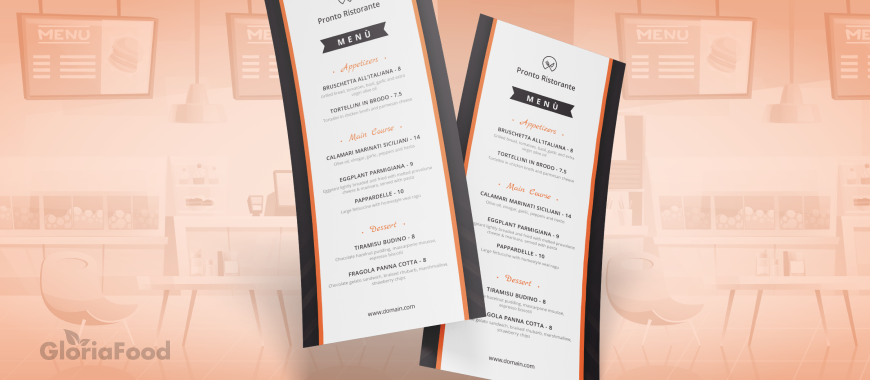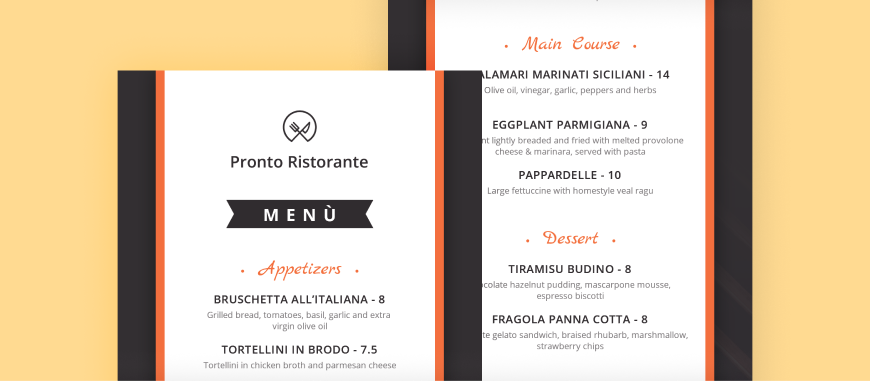The current trend in downsizing your restaurant menu has a solid basis. Restaurants with small menus fare better in today’s restaurant landscape than those with pages on pages of menu items. So what is a limited menu? One that focuses on just a few high-quality dishes cooked to perfection.
Even large chains like Chili’s and Ruby Tuesday have cut their menu by 40% and 30%. Nowadays, less is more and limited menu restaurants are thriving. Let’s find out why a small menu is better and how you can begin to create one for your restaurant using our small menu template.
- 1.Why a Small Restaurant Menu is the Key to Success
- It’s more customer-friendly
- It keeps the FOH and BOH staff happy
- It’s more cost-effective
- It helps you reduce waste and increases food quality
- It forces you to embrace your restaurant concept
- It streamlines kitchen operations
- It gives you just enough creative freedom and room for customization
- It creates a high-end feel
- It can help you support the eat local movement
- It leaves room for limited menu items
- 2.How Many Items Should Be on a Restaurant Menu
- 3.5 Small Menu Ideas to Implement Quickly
- 4.Download our small menu template to create your own limited menu
- 5.Final Thoughts
Why a Small Restaurant Menu is the Key to Success
1. It’s more customer-friendly
A limited menu size helps people decide what they want to eat faster and prevents decision fatigue. After having to sift through a lot of options, when they finally decide on something, it might not be the best choice or what they wanted in the first place. As a result, they might leave your restaurant feeling dissatisfied and never come back.
A study published in the Journal of Personality and Social Psychology shows that people would rather have fewer choices than more because it makes the decision process more manageable. Ultimately, with a smaller restaurant menu size, you give people what they want, improving customer service and their experience.
2. It keeps the FOH and BOH staff happy
Restaurants with big menus often have overworked staff. The chef has to remember how to prepare a large variety of dishes and will end up not specializing in any of them. Not to mention not all dishes will be ordered often, so they might not turn out great if your chef doesn’t have experience making them.
A smaller menu will make your front of house staff happy as well because customers will decide faster, which will improve your table turnover rate. Plus, without having to remember so much information, your servers will also be more knowledgeable about every item on the menu to answer customers’ questions.
3. It’s more cost-effective
Effective menu engineering will cut expenses and lead to a cost-effective kitchen that only uses a handful of ingredients. If you design your menu so that most of your dishes rely on the same ingredients, you will need to find fewer vendors, leading to fewer invoices.
Additionally, since you’ll only be ordering a few ingredients, you know you’ll use them all, so you can afford to order in bulk. Ordering more at once will probably get you a better deal. You will also cut costs when printing the menu because you will need less paper for a limited number of dishes.
You might also like: 4 Menu Engineering Design Tips & Secrets That Will Boost Your Sales
4. It helps you reduce waste and increases food quality
Restaurants with large menus are often forced to serve frozen items. If you want to avoid that and make sure your food quality is off-the-charts, offer a smaller menu that only uses fresh food. You know you will use the ingredients quickly so there’s no need to freeze them or, even worse, serve spoiled or rotten food.
This comes with another benefit: it reduces food waste for a more sustainable and environmentally friendly restaurant. Many of your customers will appreciate your care for the planet, which will give you great publicity.
5. It forces you to embrace your restaurant concept
An effective menu design should focus on your restaurant’s concept. If you own an Italian restaurant, focus on dishes like pasta, pizza, and a few traditional Italian desserts. It would make no sense to start serving burgers or sushi because that’s not what you’re about.
Removing unnecessary menu items will force you to rethink your entire menu and place the focus on what matters most to you.
6. It streamlines kitchen operations
Restaurants with small menus run like a well-oiled machine. That’s because the entire process is streamlined, from the customers placing the order to the chef cooking the food and the servers bringing it to the table.
Plus, you’ll serve what your chef is good at making. Instead of serving a lot of mediocre dishes, you will be focusing on a few excellent ones. Usually, people are suspicious of restaurants that offer many very different options because it’s impossible to get all of them right.
7. It gives you just enough creative freedom and room for customization
Paradoxically, one of the main benefits of a simple menu is that you can appeal to more customers while only serving a few dishes. How? By customizing as many menu items as possible for different diets and intolerances. For instance, you can sell vegetarian and gluten-free options for your main dishes.
Another way you can customize a small menu is to add a lot of topping variations like Chipotle and Five Guys. You can also rethink and change the menu whenever you want, like every month or season.
8. It creates a high-end feel
With a restaurant menu that is too big, you will never achieve that high-end feel that only restaurants with small menus have. Usually, restaurants that have pages upon pages of menu are fast foods. If you want a quality meal, you don’t go to a fast-food restaurant. A small menu is all about quality control.
9. It can help you support the eat local movement
With careful restaurant menu planning, you can show customers, especially younger ones, that you care about supporting other local businesses. The eat local movement is gaining ground as we speak. Having a menu that is limited to a few ingredients means you might be able to buy them all locally.
In particular, millennials value restaurants that source their ingredients locally. If that is your target audience or you want to appeal to them, try finding local vendors for all of your ingredients.
10. It leaves room for limited menu items
Restaurants with small menus have the added benefit of playing around with new, limited-edition menu items without worrying about cluttering an already full menu. Your chef can brainstorm limited dishes that fit your restaurant concept, and you can introduce them one at a time every few months.
Tap into some menu psychology tricks to boost your profits. People are attracted to limited-edition items, and they will be more tempted to try a dish that will only be around for a short while.
How Many Items Should Be on a Restaurant Menu
Now, the question on everyone’s mind probably is, “How big should my menu be?”. To put it briefly, it depends on your restaurant. There is no magic number of menu items that fits every restaurant out there.
However, researchers from Bournemouth University tried to look for that magic number. Their study showed that the number is six when it comes to quick service items and between seven and ten for fine dining items. Still, this is just the average number of items on a menu.
As I said, the number depends on many things, from your restaurant concept to your staffing, budget, and space requirements. In time, you will figure out what the perfect number of menu items is for you, but you will have to experiment first.
You might also like: How to Build a Restaurant Menu That Will Skyrocket Your Online Sales
5 Small Menu Ideas to Implement Quickly
These restaurant menu planning ideas are ideal for owners who want to turn their menu into a small one and don’t know where to start:
- Try to stick to one page. One-page menus are perfect for restaurants that want to switch things up and focus on doing a few dishes perfectly. No page-turning, no confusing options, just the best of the best.
- Have a simple and easy to read layout. With one-page menus, you might be tempted to crowd the dishes in there. If you can’t have a spaced-out layout, it’s better to do it on two pages. The menu should be easy to read by everyone.
- Stay away from food fads. Rather than investing time and money into changing your menu to appeal to trends, stick to the few items you make that customers love.
- Include mostly versatile items. Try to focus on menu items where you can use the same ingredients. For example, if you serve an avocado and pumpkin spread, try to find other dishes that contain avocado and pumpkin.
- Arrange the dishes to reflect a full dining experience. Even if you have a one-page menu, you should arrange the items to form a full meal, from appetizers to dessert.
You might also like: How to Promote New Menu Items Without Breaking the Bank
Download our small menu template to create your own limited menu
~ Download ~
You might also like: How to Use an Online Menu Builder to Boost Restaurant Sales
Final Thoughts
Restaurants with small menus have unlocked the door to success. Their mantra is “simple but excellent,” and that’s what you should aim for as well. More items doesn’t necessarily mean better items, in fact, quite the opposite. Having your chef specialize in making a few menu items is what makes a good menu.
Now, it’s time for you to do some restaurant menu planning and figure out what items you should keep and focus on perfecting. Use our small restaurant menu ideas for inspiration, and don’t forget to download our small menu template to customize your own limited menu. Check out more menu templates here.
You might also like: 3 Secret Menu Writing Tips: The BEST Food Descriptions that Make You Hungry

